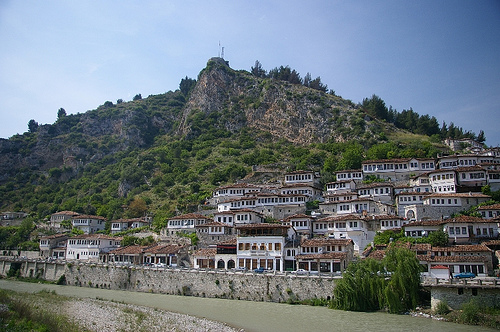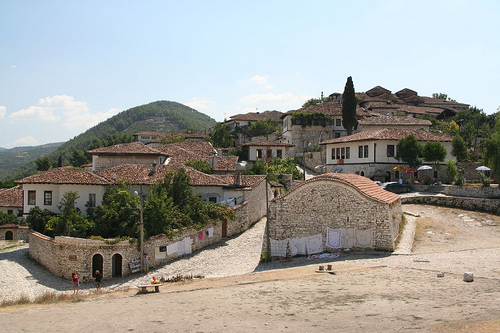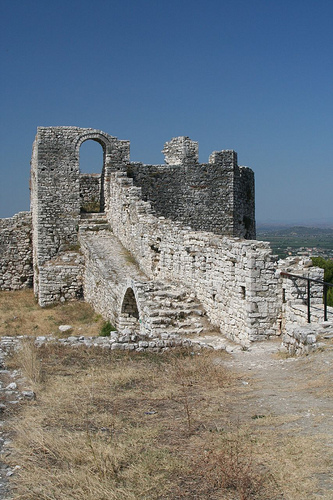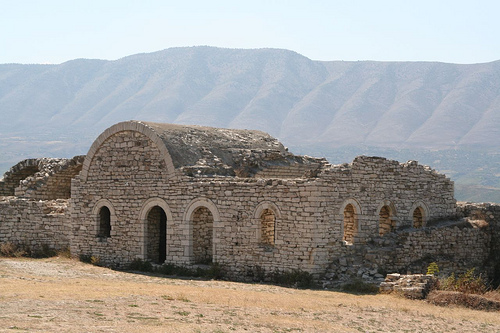

Hotels, motels and where to sleep
Restaurant, taverns and where to eat


Location: Berat, Berat County
Constructed:
current citadel is largely from the 13th century construction under
Despot of Epirus, Michael Angelus Comnenus
Entrance Fee: free
Lodging and Hotels:
Berat Backpackers
295, Gorica, Berat,
Albania
Tel. (+355) 693064429
Berat Castle is a massive medieval citadel
situated above a village of Berat in the Berat County. You can get
here by taking a bus from Tirana that lasts for 3 hours. The
entrance fee to the Berat Castle is free. It contains several
mosques and Christian churches including Church of Saint Mary, the
largest in Berat Citadel.
The strategic location of the
castle have seen several military fortifications on the same spot.
Earliest citadel built here was a wooden fortress of the Illyrian
chieftain in the 4th century BC. During Roman invasion castle was
burned down by the advancing army and subsequently reconstructed. It
was strengthened by Byzantine Emperor Theodosius II in the fifth
century and another reconstruction was undertaken by Emperor
Justinian I in the sixth century. However much of today's appearance
Berat Castle owes to Despot of Epirus, Michael Angelus Comnenus,
cousin of the Byzantine Emperor who increased the size of the
defences in the 13th century. Besides numerous churches also
contains remains of the Muslim mosque that served Turkish garrison
stationed here after local lands were conquered by the Ottomans.

Berat Ethnographic Museum
Entrance Fee: 200 leke
Tel. 032
32 224
Open: winter: 9am- 4pm Tue- Sat, 9am- 2pm Sun
summer:
9am- 1pm and 4- 7pm Tue- Sat, 9am- 2pm Sun
Ethnographic
Museum is situated below the walls of the Berat Castle in the 18th
century Ottoman house. It contains a large collection of traditional
Albanian clothes, tools and other items used by everyday people. You
can get a brochure and a guided tour around the Ethnographic Museum.
Berat Onufri Museum
Entance Fee: 200 leke
Tel. 032
32 248
Open: winter: 9am- 4pm
summer: 9am- 1pm and 4- 7pm
Closed: Mondays
Onufri Museum is a museum of local arts and
history. It is situated in the church of the Dormition of Saint Mary
(Kisha Fjetja e Shen Merlse). Before the country was conquered Kala
region of Berat was predominantly Christian neighbourhood, however
forceful conversion forced many Christians either to convert to
Islam or to flee the village. During Medieval period Berat had over
20 churches, but after the conquest of Ottoman army most of them
were destroyed. This church was one of the few exceptions. It houses
a collection of art work through out much of the year, but
occasionally it is used for Christian service.
Mangalem old town area (Below the Kala, south of the river). a
traditionally Muslim area
Gorica old town area (Below the Kala,
north of the river). A traditionally Christian area.
Of the formerly thirty Greek Orthodox churches in the castle
district, ten have survived in their almost original form. With the
exception of one, these churches also hold services on the day of
their patron saints.
The most significant of them in
architectural history is the Church of the Blessed Virgin Mary in
Blakhernai, built in the Byzantine style in the 13th century, which
is one of the oldest surviving churches in Albania. A 5-6. It was
built on the site of a 16th-century convent, originally with a
vaulted dome structure, which, however, was damaged in the 16th
century and replaced with a gabled roof. The frescoes depicting
biblical scenes and saints in a building with an unusually high
rising wall and a rectangular floor plan were made in 1578 by
Nikollë Onufri. The stone floor of the naos (church square) also
features a 16th-century mosaic. On the northwest wall of the church
is a large bust of St. Constantine.
In terms of antiquity,
this is followed by 13-14. The Church of the Holy Trinity was built
at the turn of the 19th century and adheres to the west wall of the
inner castle. The interesting thing about the church, which is also
a Byzantine style, but has a Greek cross-floor plan, is that the
structural levels of the narthex (foyer), naos and adyton (altar
part) are shifted from each other. Its interior is divided by late
ancient columns supporting the dome drum. It was used as a gunpowder
depot in Ottoman times, so the frescoes were damaged, but some
murals have survived in fragments. The interior of the church is
rarely visited.
Once in the lower castle area, below the
southern ridge, today it is more accessible from the riverside
Mangalem district, one of the three oldest churches in the castle
and Berat, the Church of St. Michael. The 14th-century church sits
on a small cliff face of the castle hillside, and although it is one
of the smaller churches in terms of floor area, its architecture
bears a mature late Byzantine style. On the west side, an
east-facing, Greek-cross-plan church bordered by narthex has an
imposing dome. His frescoes have survived only in fragments.
The most spectacular and one of the largest churches in the
castle district is the three-aisled Cathedral of the Assumption of
the Blessed Virgin Mary, built in 1797 in late Byzantine style.
Built using the partial reuse of the foundations and walls of a
former 13th-century church, the saddle roof of the church is closed
by two domes, and a stone belfry breaks through the sanctuary. Its
southern longitudinal wall is bordered on one side by an open,
columnar, porch-like exonarthex. The carved sanctuary of high
artistic value (1811) and its iconostasis (with paintings by Onufri
and Joan Çetiri among the icons) and similarly artfully carved
stalls, pulpit and episcopal throne have been preserved in the
congregation space. A symbolic sun depiction of colored stone slabs
can be seen on the floor under the southeast dome. Behind the shrine
lock, hidden in the floor, the extremely valuable 6th-century Berat
Purple Codex and the 9th-century Anthim Golden Codex were found in
1968. The Onufri National Museum of Iconography has been housed in
the building since 1986, with a permanent exhibition of Albanian
icon painting related to Byzantine art traditions, Onufri, Nikollë
Onufri, David Selenica, Joan Çetiri and others, and masterpieces of
ecclesiastical goldsmithing around Berat.
In addition to the
above, there are seven other Greek Orthodox churches, which have
been preserved in their almost original condition. From the point of
view of art history, the most significant of them is the Church of
St. Theodore, built in the 16th century, which shows the only
surviving fresco by the 16th-century Albanian painter Onufri. Also
16th century is the Church of St. Nicholas, with fragmentary
frescoes by Onufër Qiprioti in the interior. In addition, the
surviving churches of Berat Castle are the late 16th century Church
of the Annunciation (Kisha e Shën Evangjelizmoi), the Church of St.
Demeter (Kisha e Shën Mitrit) built in 1607, the 17th century Church
of St. Constantine and St. Ilona. , the Church of St. Sophia (Kisha
e Shën Sofisë) and the Church of St. John the Golden Mouth (Kisha e
Shën Joan Gojartit). Of particular note is the Church of St. George,
built in the 14th century but transformed into a traditional
Ottoman-style restaurant with a terrace in the last third of the
20th century, which has been derelict since the 1990s.
Numerous Byzantine Churches, dating from the 13th century.
St
Mary church (Kisha e Shën Mari Vllahernes), next from Rrugica
Panajot Haxhimihali (within the Kala). St. Mary of Blachernae
Church.
Church of St Demetrius (Kisha e Shën Mitrit) (within the
Kala).
Church of St. Theodore (Kisha e Shën Todrit) (Kala
northern part).
Church of St. Sophia (Kisha e Shën Sofisë)
(within the Kala). edit
Dormition Cathedral (Center of the Kala).
Dormition of St. Mary Cathedral.
Holy Trinity Church (within the
Kala). Holy Trinity Church.
Saint Michael Church (Kisha e Shën
Mëhilli), Rruga e Shën Mëhilli. St. Michael's Church.
Cathedral
of St. Bitri (Katedralja e Shen Bitrit), Rruga Antipatrea and Rruga
Rilindja corner.
The two oldest mosques in Berat, located in the castle district, were built for the Turkish soldiers of the garrison after the Ottoman occupation of the castle in 1417. The ruins of the older Red Mosque are located southeast of the inner castle, in the southern part of the castle district. As a result of the bombings of the Second World War, its roof structure was destroyed, and today only its remains and the lower part of the minaret stand. The peculiarity of the latter is that, unlike the Muslim building traditions, it was placed not to the right but to the left of the mihrab. The White Mosque has survived in a slightly younger but more ruined condition. The remains of the prayer hall and minaret of the mosque in the northern corner of the inner castle stand about 2 meters high.
Several Mosques from the Ottoman era (starting from 1417).
Sahatit Mosque (Clock Mosque, Xhamia e Sahatit), Rruga Xhamia e
Sahatit.
Kuqe Mosque (Red Mosque, Xhamia e Kuqe), Rrugica Mbrica
(South part of the Kala).
Bachelors' Mosque (Xhamia e Beqareve),
Rruga Antipatrea.
Mbret Mosque (King Mosque, Xhamia Mbret), Rruga
Mihal Komnena.
Tekke of Helveti (Teqeja e Helvetive). Halveti
Teqe
Lead Mosque (Xhamia e Plumbit), Rruga Gaqi Gjika. Lead
Mosque.
Tomorri Mountain (Parku Kombëtar
Mali i Tomorri) (20 km east of Berat. Can be reached with 4x4
vehicles). A national park. - At mountain peak a Bektashi Temple is
located
Bogova Waterfall (Ujëvara e Bogoves), Bogovë village (30
km south of the city, between Berat and Corovode.).
Osumi River
Canyon (58 km south of Berat. Skrapar District). One of the most
beautiful rivers in Albania passing through canyons as high as 100
meters. Outdoor Albania offers a 3 hour rafting experience inside
the canyons.
The town of Berat did not extend beyond the walls of the castle
until the 15th century, so the history of the town and the castle
did not separate in these early centuries. Based on the
archeological finds found in the area of the castle, the i. e. In
the 7th century, the Dasaretas (Δασσαρῆται) belonging to the
Illyrian tribal settlement settled and established their central
settlement protected by a stone wall. King of Macedonia, Kassandros
i. e. In 314 he occupied a settlement on the western frontier of his
empire, which he named Antipatreia. He fortified his defenses, not
long after, in i. e. 4–3. At the turn of the 19th century, he had a
fortress built on the hilltop on the other side of the river Aposz
(today Osum). The castle remained in the hands of the Macedonians
for a century, i. e. In 200 it was occupied by the Romans. In the
following centuries of antiquity, the castle remained inhabited, but
it lost its military significance.
I. sz. 440 in II.
Theodosius occupied and made the castle part of the Byzantine
Empire, which he named Πουλχεριόπολις / Pulkheriopolis. A century
later, during the reign of Justinian I (527-565), the still standing
antique castle walls were fortified. In 860 the castle came under
the rule of the Bulgarian Empire, and in 1018 again the Byzantine
Empire. After that, until the 15th century, the military events
around the castle intensified, as a result of which he often changed
hands. In 1082 the castle was occupied by the Normans, which in 1085
again became a Byzantine dominion. In 1205, the first ruler of the
Epirus Despotate, Michael I, conquered the castle, whose
fortifications were significantly strengthened. In the present form
of the Berat castle, the castle walls reinforced with a tower system
enclosing an area of 9.6 hectares, the inner castle, the castle
gate protected by a barbican, etc. all the results of the 13th
century castle-building activity of Michael I. In 1258, the castle
was donated to King Manfred of Sicily, and then became part of the
Kingdom of Arberia, proclaimed in 1272 by his successor, Charles I
(Anjou). In fact, the Albanian fiduciaries of Charles, members of
the Muzaka family, controlled the area around the castle, from whom
Berat was recaptured by the Byzantines in 1274. The Anjouk attempted
to recapture the castle in 1280–1281, but their siege ended in
failure. Thereafter, the Muzakas were again the lords of the castle,
except between 1345 and 1355, IV. (Dusán) Serbian authority
associated with István's name.
In 1417, the castle was
occupied by the Ottoman Empire, which was expanding in the Balkans,
and its fortifications were slightly enlarged, and two mosques were
built for the Turkish garrison. Skander Beg, who liberated Albanian
territory, besieged the castle in 1455, but was defeated. In the
following period, the city spread beyond the castle walls, in the
areas below the castle hill, and on the two banks of the Osum, newer
neighborhoods were formed: Mangalem, which had a predominantly
Muslim population, and Gorica, inhabited by Greek Orientals. With
this, the population of the Berati vilajet, and then from the 17th
century as the seat of the Sandzak of Avlona, increased
significantly. The castle was still stationed by the Turkish
garrison, but the population of exclusively Orthodox religion also
remained in place; the number of Greek Orthodox churches in the
castle area in the modern centuries exceeded thirty. At the
beginning of the 19th century, the town became the temporary
property of Pasha Ali Tepeleni, an Albanian warlord from the Epirus
territories, who also took care to strengthen the castle.
When Albania became independent (1912), Berat came under the rule of
the Provisional National Government, but during the First World War
it was under Greek (1914–1916), Austro-Hungarian (1916–1918), and
then Italian (1918–1921). In 1925, a garrison was assigned to one of
the corps of the regular Albanian army in Berat Castle. On the eve
of World War II, on April 9, 1939, the Italians occupying Albania
marched into Berat. The castle suffered significant damage in 1941
as a result of the bombings of the Royal British Air Force.
Following the capitulation of Italy, on September 8, 1943, soldiers
from the Third Reich invaded the city, which was finally liberated
on May 16, 1944 by the Communist partisans.
The castle is a
protected monument since 1948 under number XX0064. In 1961, the
Albanian government declared Berat a museum city, so that otherwise
aggressive urbanization efforts across the country spared the
historical memories of the city and castle, and even its churches,
from the mindless church ruins of the post-1967 atheist campaign.
The castle is located on the northwest of today's Berat city center, on the top of a steeply rising castle hill on the right bank of the Osum, on 9.6 hectares. Its highest altitude is 229 meters, and the castle gate itself is 181 meters. The castle of Berat is still a residential area, and although it can be reached on foot from several directions, at the north-eastern gate of the castle, tourists are charged a ticket at a symbolic price during the day.
Thanks to the reconstruction work of the last hundred years, the
outer wall of the castle has been preserved in good condition along
its entire length. Archaeological excavations have identified the
layers of the original Macedonian castle wall and castle gate that
are now 5 meters below ground level, and material studies have
confirmed that indeed the i. e. They can be dated to the 4th
century. The original quadrangular stones were also used during
historical centuries to rebuild the dilapidated castle walls. The
external fortifications visible today are ultimately the results of
the work of the 13th century castle builder of the ruler of the
Epirus Despotate, Michael I. At that time, a nearly triangular floor
plan of the castle was formed, a barbican was built to protect the
castle gate, and a fortification consisting of twenty-four towers
dividing the castle wall was built. At the castle gate, the ancient
layers can be separated from the 13th-century Epirus and
19th-century Ali Tepeleni extensions with the naked eye. In the wall
above the inner arched gate, the monogram of the builder despota,
known in Greek as Michael Comenius, can be seen laid out of green
brick. At the outer castle gate is a cannon capable of firing
6-9-pound bullets looted from the Venetians, the barrel of which
bears the date 1694. In the square on the inside of the castle gate
stands a church-like building erected above a cistern supplying the
population of the castle.
Michael I also built the
0.8-hectare inner castle at the highest point of the hill, as well
as the five old towers that ensured its protection. At the southern
end of the inner castle is a hall cistern, also built in the 13th
century, carved into the rock and supported by arched brick columns,
which was intended to provide water to the castle garrison. In the
1930s, instead of catching rainwater, the water from the springs of
Mount Shpirag, 7 km away, was introduced into the cistern.
Presumably during the 14th century, fortifications were built for
Osum, south of the southern wall of the inner castle and south of
the southeastern rampart, which partially enclosed the lower castle
in today's Mangalem district, increasing the castle's floor area by
an additional 6 hectares. On the steep ground of the lower castle
was later built a seragia, and in the 18th century the palace of
Pasha Kurd of Berat, Sandzakbeg. The ruined walls of these, the
finely carved original stone gate of the palace and part of the
haremlik (family living space) can still be seen today. The
southeastern promontory overlooks the Osum Valley, the downtown
below and the historic districts of Mangalem and Gorica.
Get in
Take a Furgon/Van from Tirana to Berat (cost: 500 lek).
From other towns make a connection via Fier (200-250 lek). Buses
also run from Tirana to Berat (cost: 400 lek). To Sarandë (via
Gjirokastër), departs 8AM and 2PM daily, 6 hours (1000 lek). Buses
to major towns in Albania from Berat. Check the board at the bus
station for destinations and departure times.
Get around
The town is small enough to be toured by foot. Taking a walk on the
footpaths of the old town is a must!
Accommodation is mainly in the form of private rooms as many
traditional house owners have turned their localities into B&B.
Hotels are also available.
Berat Backpackers, Rruga Nikolla
Buhuri 295, Gorica, ☎ +355 693064429. Berat's hostel. Prices from
1350LEK
Hotel Mangalemi, Mangalem District, ☎ +355 32 232 093.
Hotel Nasho Vruho, Rr. Llambi Guxhumani, Mangalem District, ☎
+355 32 232355.
Lorenc Guesthouse & Hostel, Stiljano Bandilli
Road, Porta 18 (cross the old bridge of Gorica, there is the square
Alfred Gimitiku and you will see the Road), ☎ +355 696337254. Nice
private guesthouse in an old quarter of Gorica. It's run by Lorenc
and his mother, feels like home. €12.
Hotel Palma, Rruga Santa
Lucia (across the street from the Bachelors' Mosque, near the
bridge), ☎ +355 32 232143. Comfortable air-conditioned room with
king size bed for €30 per night, buffet breakfast included. Some of
the staff speak English.
Rice with turkey-cock (Pilaf me kaposh deti)
Mont Blanc pastry
named after the white peak of Tomorri Mt
Try the delicious figs
and olives of the area.
There is a traditional restaurant just inside the Kala area that
does very good food.
Guva Mangalem Hotel-Bar-Restaurant, Rruga
Llambi Guxhumani, e-mail: info@guvamangalem.com. Average. - Rooms:
Air Conditioning, Room Service, Internet, Bathroom
Ajka
Restaurant (across the Osum River). Delicious food with an excellent
view.
Drink
Try traditional Raki made from walnuts (Raki
me arra), and peculiar juice made from roses.
Cobo Winery.
Features locally made wine and a winery tour.
Traditional souvenirs include stone carving, wood cheeping, and textile products.